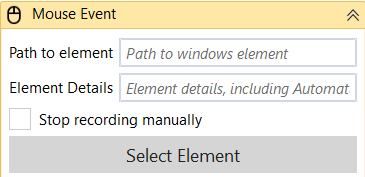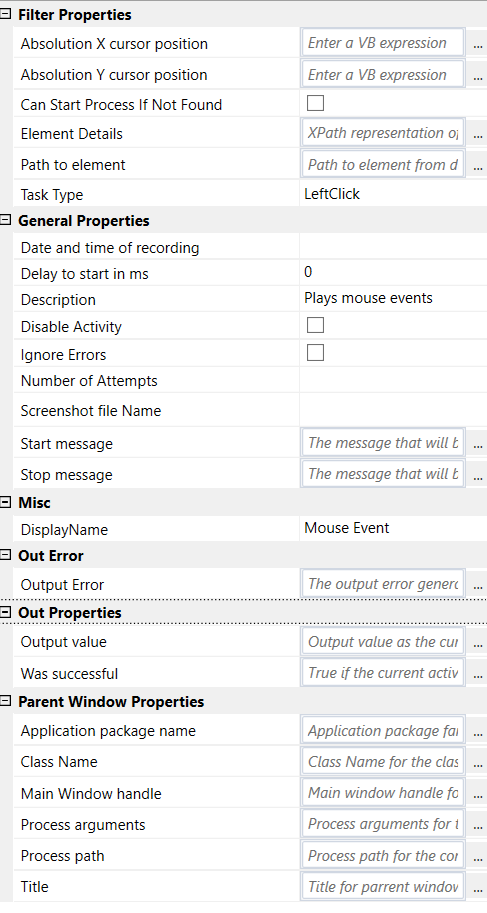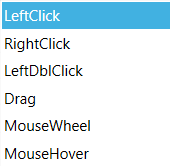Mouse
The mouse activity simulates mouse events on desktop.
To use the mouse activity, we first have to locate the Windows application element that we require. We do this by using the information provided in Path to element and Element details. Should the mouse activity be unable to locate the required windows application element, we then use the screenshot, captured at recording, to match that against the desktop applications in order to find the right element. Should the activity again fail to locate the required windows application element, the activity will use the Absolute position, which will be found in Filter Properties.

Designer Properties#
- Path to element Points to the location of the application window on the desktop containing the element required. When Path to element is specified, the activity will focus onto the application window element pointed to the path entered.
- Element details Contains the details to find the element. This may be the automation id, class name, name.
- Stop recording manually Controls how the recording is stopped. When checked, the recording will be stopped only when the 'Stop recording' button is pressed, otherwise the recording is stopped with the following combination CONTROL followed by left/right ClickPath to element and Element details will be set to the last element that was clicked(left or right)
- Select Element Starts the recording of a target element on a desktop application which will receive the click event. The element can be selected using CONTROL followed by left/right Click. If we use this option, Path to element and Element details will be set to the last element clicked while CONTROL key was down, and the recording will be stopped, otherwise Path to element and Element details will be set to the last element clicked(left/right) after either STOP button was pressed, or the STOP hot key was used(ESC by default).
Properties#

Filter Properties#
Absolute X cursor position See Filter Properties.
Absolute Y cursor position See Filter Properties.
Can Start Process If Not Found See Filter Properties.
CV threshold See Designer Properties above.
Element details See Designer Properties above.
Element Index See Designer Properties above.
Path to element See Designer Properties above.
Stop Id preprocessing See Filter Properties.
Task Type Is the mouse event to be simulated. The supported events are:

All the following events can be triggered after the corresponding element is found using the Path to element and Element details.
- LeftClick Triggers a left click event on the found element.
- RightClick Triggers a right click event on the found element.
- DoubleClick Triggers a double click event on the found element.
- Drag Triggers a drag event on the found element. For more details, please check Drag Delta under Mouse Properties.
- MouseWheel Triggers a mouse wheel event on the found element. For more details, please check Wheel Data under Mouse Properties.
- MouseHover Triggers a mouse hover event on the found element.
Use CV See Filter Properties.
Use Relative position See Filter Properties.
General Properties#
See General Properties.
Misc#
See Misc.
Mouse Properties#
- Drag Delta X The drag delta on X axis for the selected element. This property is valid only for Drag Mouse events. A Drag Mouse drags the corresponding element on X and Y axis by Drag Delta X and Drag Delta Y
- Drag Delta Y The drag delta on Y axis for the selected element. This property is valid only for Drag Mouse events. A Drag Mouse drags the corresponding element on X and Y axis by Drag Delta X and Drag Delta Y
- Wheel Data Represents the wheel movement for Mouse wheel activities. A positive value indicates that the wheel was rotated forward, away from the user; a negative value indicates that the wheel was rotated backward, toward the user. One wheel click is defined as WHEEL_DELTA, which is 120.
Out Error#
See Out Error.
Out Properties#
See Out Properties.
Parent Window Properties#
Example#
In this sample, we start the Microsoft Windows calculator program using the windows ‘run’ command by typing "Calculator". The mouse activity will now click on the calculator keypad to enter two numbers and complete the sum calculation on those two numbers.
This sample is installed automatically when you install Rinkt Studio, but you can download it from here as well. Simply import the sample file using the Open menu in Rinkt Studio.